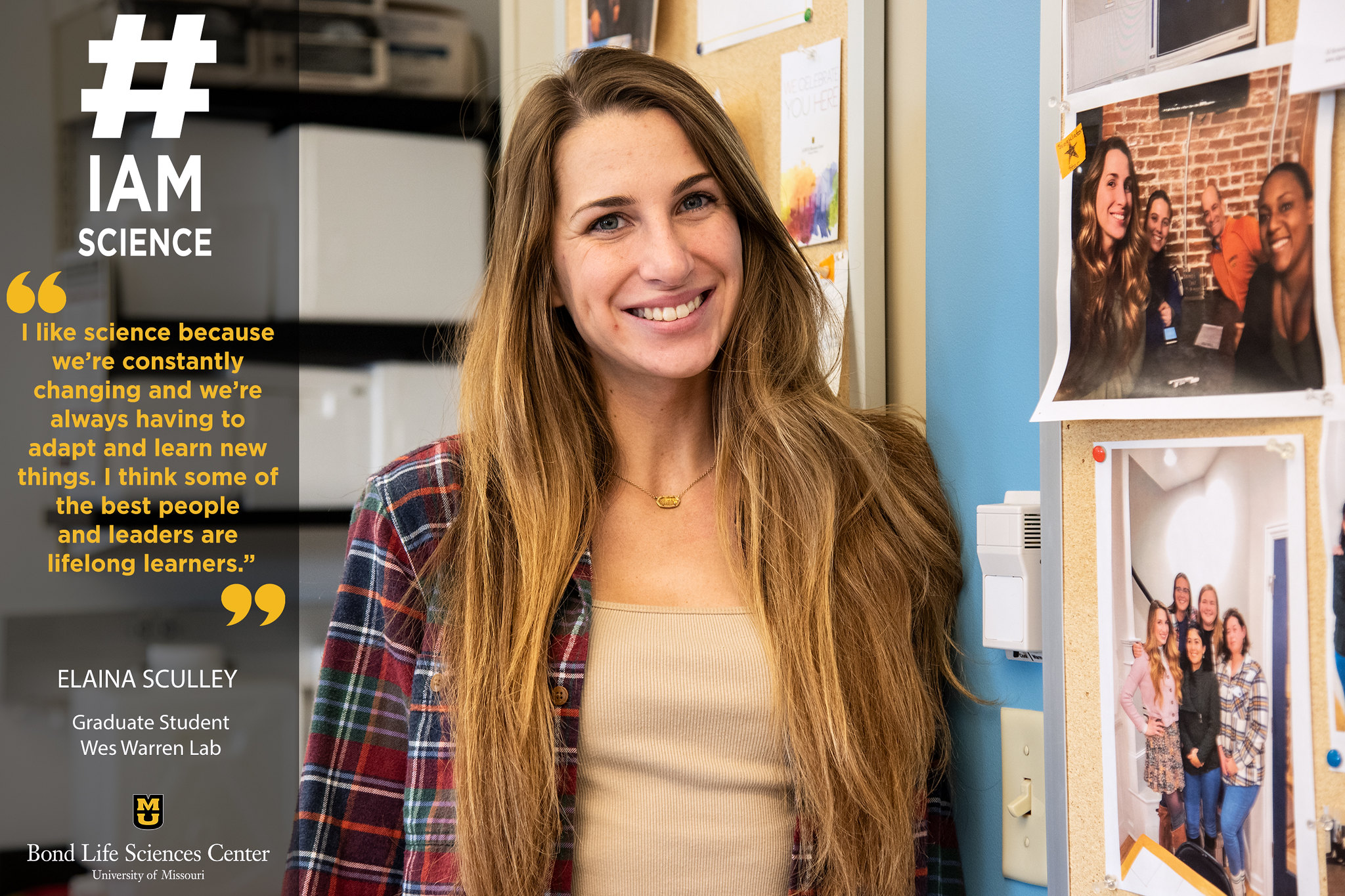Published on
For Elaina Sculley, the word filter means much more than narrowing down your search results on a website.
The second-year animal sciences graduate student spends her days using computer programming tools as part of her bioinformatics studies and her work in Wes Warren’s lab at Bond LSC. Her focus is on the chicken immune response because they serve as invaluable models for studying immunology due to their widespread use in both commercial breeding and scientific research.
Her main objective when studying host immune response is to gain a better understanding of candidate genes and pathways involved in the immune response which is crucial to determine the underlying mechanisms of immunity and the potential in genomic selection schema.
“I think it’s something that is fascinating because it is yet to be fully understood, which sparks my interest,” Sculley said. “There are so many different components and factors that play a role in how chickens respond to a bacterial pathogen.”
Sculley earned a bachelor’s in animal sciences and a certificate in animal nutrition from Colorado State University. Her background in both wildlife animals and agriculture helps her understand the detrimental effects diseases can have on a variety of species.
In the U.S. there are billions of chicks hatched each year and they are among the world’s most important food source, which means their resilience to pathogen infection is an immense economic concern worldwide. Therefore, managing bacterial infections in the poultry industry continues to be important for protecting a global food supply. In recent years, more emphasis has been placed on enhancing host resistance, which has various external factors influencing each bird’s level of immunity. Her goal is to create strategies that enhance the hosts immune response and minimize the infectious disease impact they have on the poultry population worldwide.
She splits her time in the Warren lab working on bioinformatic analysis for 80% of the time and spending the other 20% doing wet lab procedures. Sculley isolates nuclei and high-molecular-weight DNA from tissue samples during her wet lab time and sends the samples off to the University of Missouri Genomics Technology Core for single nuclei RNA sequencing.
Once Sculley receives the snRNAseq data from the Genomics Technology Core, she determines which genes are up or down regulated in response to the bacterial pathogen.
She takes the snRNAseq results and uses a Seurat pipeline – a more specific form of bioinformatics analysis – to create cell type clusters based on similarities between cell types. For example, if a gene is up regulated or down regulated in response to a bacterial pathogen in the chicken spleen, Sculley can draw connections about why that might be based on the cell type identity of the cluster that the gene was found. The insights gained from these findings could contribute to the development of gene candidates that when selected upon offer effective new strategies to enhance immunity against bacterial infection in poultry populations.
Similar to a game of Tetris, each cluster of cells must be sorted into groups and certain elements must be removed in order to piece together the puzzle and win the game – or in this case, break down the chicken’s genetic code.
“This is mostly trial and error, where you manipulate the data in a way that is informative,” Sculley said. “It’s really complex. Sometimes I have to start over and rerun it through the same pipeline to make sure it all aligns in order to get the analysis to work. It takes a lot of patience and willingness to start over.”
As Sculley types away at her desk, she finds that minor edits she makes to the code make all the difference and contribute to an increased understanding of the chicken’s response to a bacterial challenge.
“It can be very draining and stressful when you don’t get informative output and you’ve been working on something for hours,” Sculley said. “You just have to be like, okay, I didn’t get it this time, but I’m going to go back later when I have a fresh mind because pushing myself to a point of burnout isn’t going to fix anything.”
Another way Sculley prioritizes her work-life balance is through a routine at home, free of screen time after a full day on the computer.
“I like this type of work and I work hard, but I enjoy going home, unplugging, and doing my hobbies.” Sculley said. “I love to do yoga and hang out with my French bulldog, who is very playful. She’s my bestie.”
When Sculley was in her first year of graduate school, she had classes and homework on top of laboratory work, filling her days with computer programming. But now, she finds that working with data for publication and having more flexible deadlines helps her have a work life balance.
She plans to apply for a Ph.D. program by the end of the year and continue to study avian single-nuclei studies to expand her knowledge of immune cell types in chickens, as well as their transcriptional responses to bacterial pathogens. The identified gene expression signatures and enriched immune-related pathways in her studies provide a foundation for future research in poultry immunogenetics and disease resistance. Her goal is to develop effective strategies to enhance immune responses and mitigate the impact of infectious diseases in poultry populations worldwide.
“I like science because we’re constantly changing and we’re always having to adapt and learn new things,” Sculley said. “I think some of the best people and leaders are lifelong learners.”
